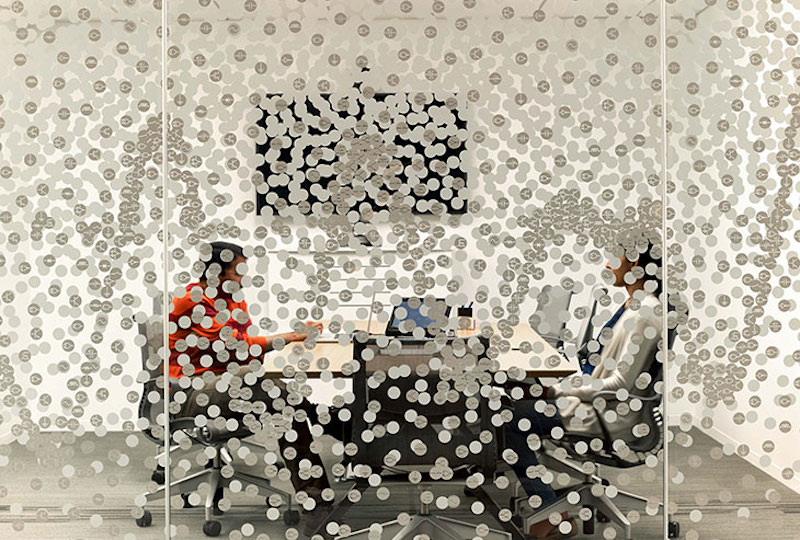Last year, we ran a blog series on Reimagining Learning in which our team defined six learning behaviors—acquire, experience, collaborate, and reflect, master, and convey—and identified how physical space can support them. As companies are increasingly looking for people who can do things like communicate clearly, solve complex challenges, lead teams and define strategic direction, a growing number of learners are turning to any resource where they can learn these skills quickly, effectively and in sync with their busy lives. Thus far these skills have been taught in-person, but today many online resources are successfully teaching them in an entirely digital environment.
As an example, Northwestern University is running a course series called Organizational Leadership via Coursera that equips leaders to “lead in an ever-changing business environment.” The curriculum centers on developing skills that are not only critical for leaders at all levels of organizations but for any professional growing in his or her career – skills like storytelling, communicating, vision definition, conflict resolution, persuasion, design thinking, ideation and team management.
Having recently completed the course series, I was impressed at how successfully it taught these skills utilizing an entirely digital interface. Yet my experience also prompted me to wonder what possibilities could emerge if we could insert the physical environment into this digital classroom. As a thought-starter, I’ll propose several ways in which this could happen, using some of our recent projects as examples.
Communicating a Pitch
One assignment asks learners to imagine themselves in the position of a Senior VP of a company. The task is to create a pitch – a two-minute elevator speech – to present a plan to the company leadership for funding and supporting the development of an innovation created by a team member. Coming up with a succinct, compelling story is challenging in itself, but what if learners also had to present their pitch? Offering a physical space in which learners could come together at a designated time to practice and critique each other’s pitches could dramatically supplement the exercise. Here are a couple of ways this might play out at Capitol Federal Hall, the School of Business at the University of Kansas:
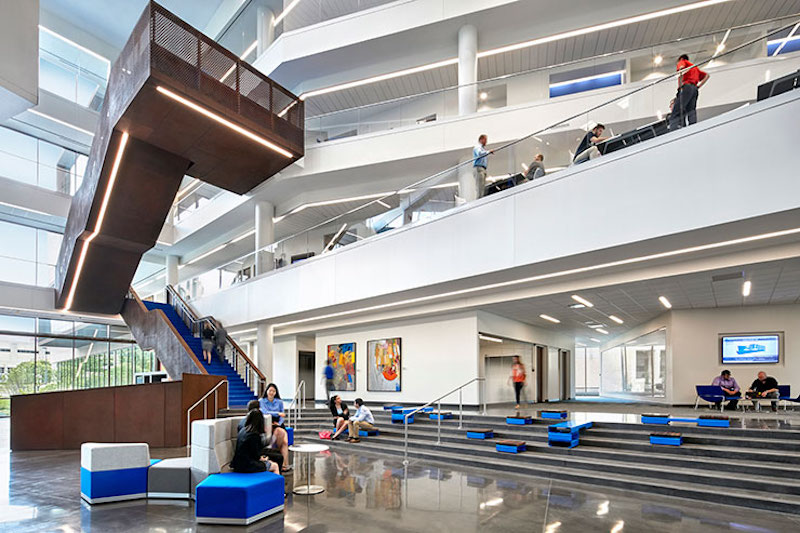 KU wanted to create a space in which students could practice their presentations and digitally record them in order to refine their communication styles and techniques. These smaller, defined meeting rooms are adjacent to a more open and fluid student workspace. Image © Gensler.
KU wanted to create a space in which students could practice their presentations and digitally record them in order to refine their communication styles and techniques. These smaller, defined meeting rooms are adjacent to a more open and fluid student workspace. Image © Gensler.
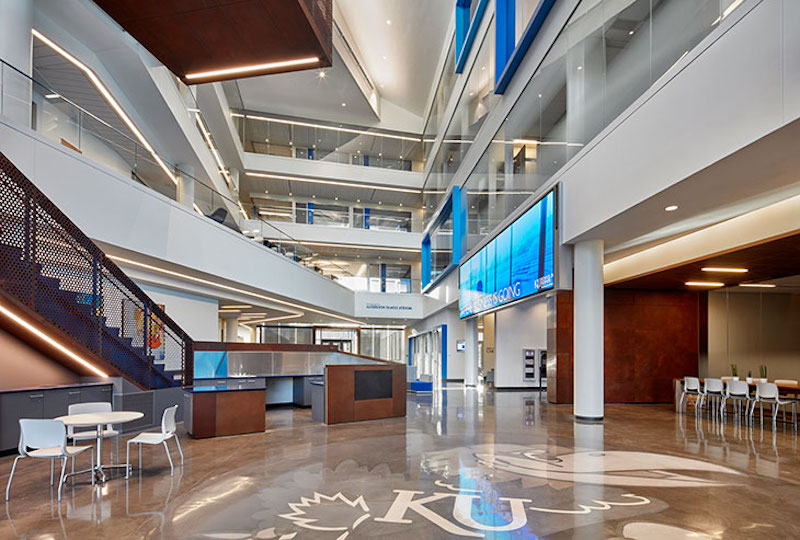 At the same time, the digital screen in the building’s main atrium is intended to show current work happening throughout the school. This screen could be an ideal vehicle for displaying student pitches that were really successful or even those that weren’t as learning opportunities for others. Image © Gensler.
At the same time, the digital screen in the building’s main atrium is intended to show current work happening throughout the school. This screen could be an ideal vehicle for displaying student pitches that were really successful or even those that weren’t as learning opportunities for others. Image © Gensler.
Hosting a Design Thinking Jam
Another course in the series on Design Innovation takes learners through a design thinking process of observation, ideation, synthesis, prototyping, and gathering user feedback. To further encourage collaborative brainstorming, the course could provide space in a local innovation lab for students to come together at designated times. Learners could sign up and indicate whether they expected to lead the session to develop their own idea or participate in helping others ideate theirs. This opportunity to engage in a session together would give learners a chance to practice facilitation—a skill that comes in handy in many situations at work, no matter the industry or task – and learn ways to optimize brainstorming. The Garage at Northwestern University offers spaces to engage in all of the phases of the design thinking process with the benefit of having other peers on hand for an impromptu design jam or critique:
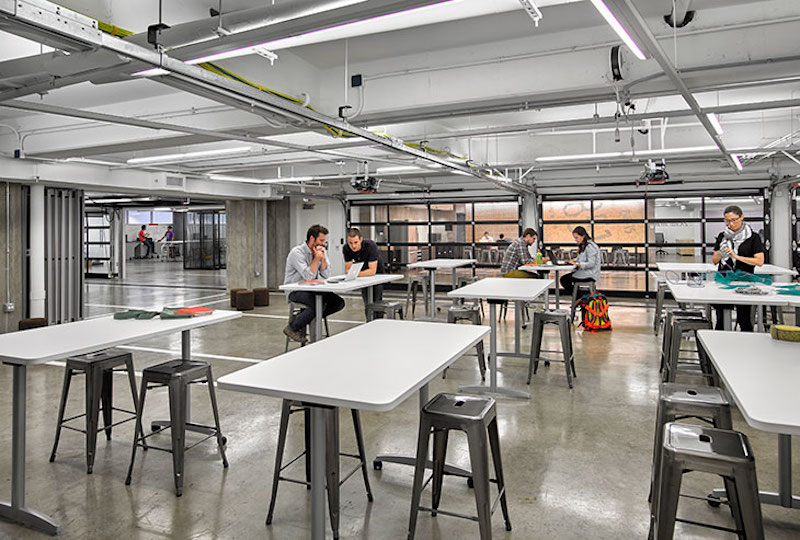 The Garage at Northwestern provides a variety of work zones, depending on the activity: open team space, classrooms with work benches, a cafe, and small meeting rooms. Image © Gensler.
The Garage at Northwestern provides a variety of work zones, depending on the activity: open team space, classrooms with work benches, a cafe, and small meeting rooms. Image © Gensler.
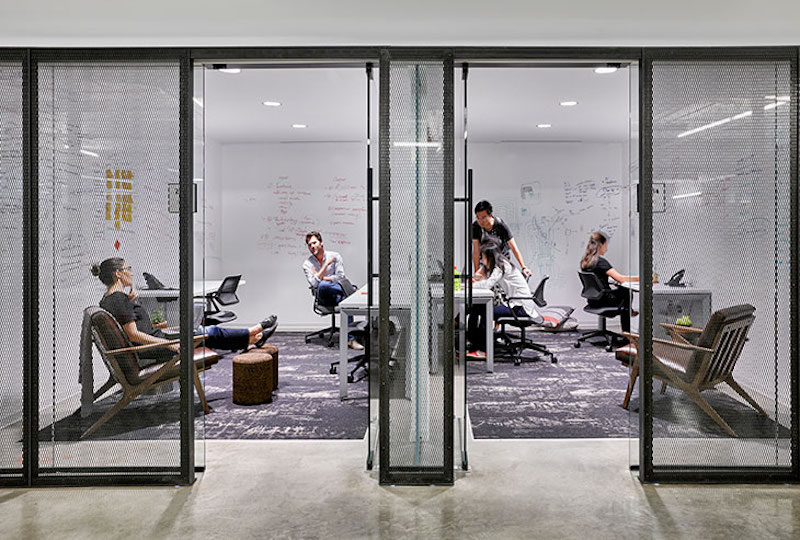 Ideation space at the Garage: On hand are writable surfaces and digital screens on which to present ideas and organize concepts; elements like glazed walls and curtains provide connectivity across the entire space, allowing groups to simultaneously focus on their task but find inspiration in the work happening around them. Image © Gensler.
Ideation space at the Garage: On hand are writable surfaces and digital screens on which to present ideas and organize concepts; elements like glazed walls and curtains provide connectivity across the entire space, allowing groups to simultaneously focus on their task but find inspiration in the work happening around them. Image © Gensler.
Create a Team Cohort
Many higher education programs structure learning curricula around student cohorts, but – although workplace settings require a great degree of teamwork – cohort learning opportunities are less common at work. This type of course series seems well-suited for a team that works together in the professional world to enroll, and it teaches skills that would likely have a dramatic positive impact on a team’s performance if collectively learned together. There are multiple places in the work environment in which a team could come together to discuss assignments, ideate, synthesize concepts, and give constructive feedback; at Motorola Mobility in the Merchandise Mart:
 Motorola integrated spaces that would work well in supporting these team cohort learning opportunities, including: large, flexible multipurpose rooms; informal spaces like the café; conference rooms for small groups; and war rooms for ideation. Image © Gensler.
Motorola integrated spaces that would work well in supporting these team cohort learning opportunities, including: large, flexible multipurpose rooms; informal spaces like the café; conference rooms for small groups; and war rooms for ideation. Image © Gensler.
Faculty Fireside Chats
The involvement of Northwestern's world class faculty sets this course apart from others, but the current course structure limits their contributions to presenting content in the lecture videos. There were several topics - like conflict resolution and persuasion - for which I felt an in-depth, in-person discussion with that faculty member would augment the course material. One way to provide an opportunity to explore some of the course themes more deeply and connect learners with faculty would be to host monthly faculty fireside chats at venues around the city.
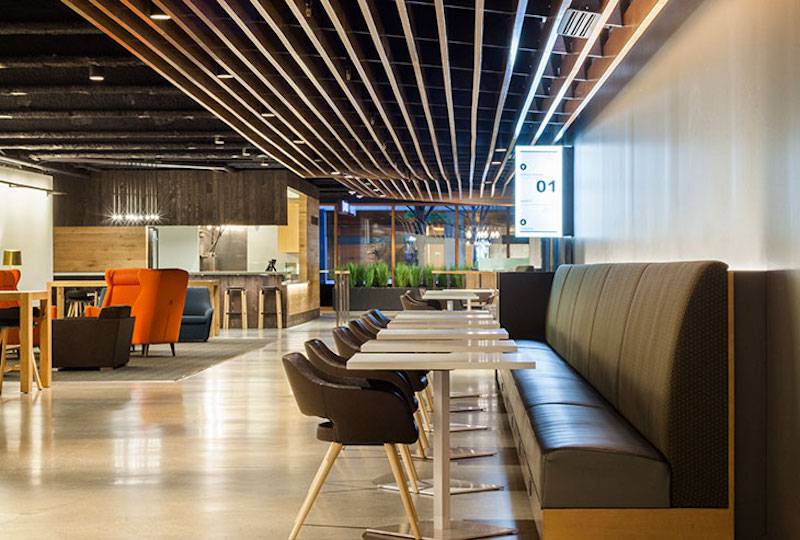 The Century Square Dining and Cafe in Seattle is one example that offers a casual yet sophisticated environment, providing alternative working, meeting and social spaces. Image © Gensler.
The Century Square Dining and Cafe in Seattle is one example that offers a casual yet sophisticated environment, providing alternative working, meeting and social spaces. Image © Gensler.
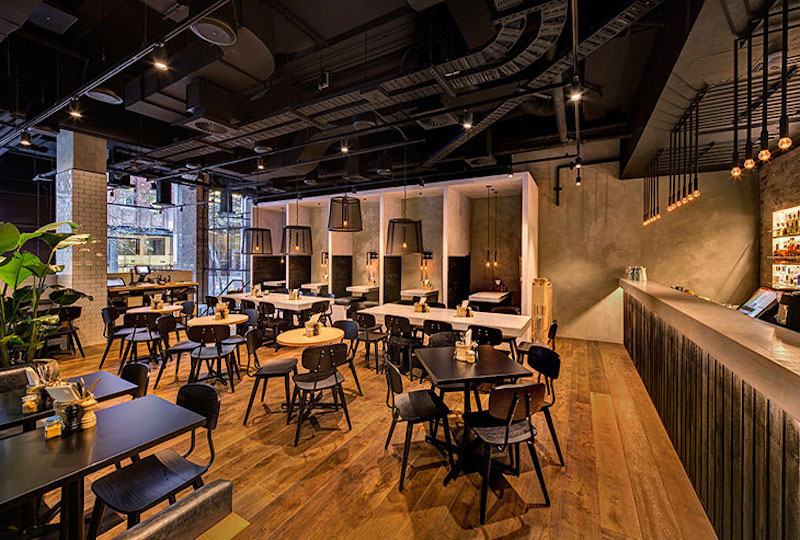 Bowery Lane in Sydney offers another option with a variety of seating options that can accommodate a small or expansive group. Image © Gensler.
Bowery Lane in Sydney offers another option with a variety of seating options that can accommodate a small or expansive group. Image © Gensler.
The above ideas are just a start, and we invite you to join the conversation with other ideas for integrating physical space into the digital classroom. As alternatives like personalized learning pathways and open source content have emerged as the new norm, the conversation is just getting started. So dream into what these evolutions could be with us, and send us your ideas!
More from Author
Gensler | Oct 21, 2024
3 surprises impacting the return to the office
This blog series exploring Gensler's Workplace Survey shows the top three surprises uncovered in the return to the office.
Gensler | Jun 26, 2024
5 ways ESG can influence design and create opportunities
Gensler sustainability leaders Stacey Olson, Anthony Brower, and Audrey Handelman share five ways they're rethinking designing for ESG, using a science-based approach that can impact the ESG value chain.
Gensler | May 20, 2024
10 spaces that are no longer optional to create a great workplace
Amenities are no longer optional. The new role of the office is not only a place to get work done, but to provide a mix of work experiences for employees.
Gensler | Apr 15, 2024
3 ways the most innovative companies work differently
Gensler’s pre-pandemic workplace research reinforced that great workplace design drives creativity and innovation. Using six performance indicators, we're able to view workers’ perceptions of the quality of innovation, creativity, and leadership in an employee’s organization.
Gensler | Mar 13, 2024
Trends to watch shaping the future of ESG
Gensler’s Climate Action & Sustainability Services Leaders Anthony Brower, Juliette Morgan, and Kirsten Ritchie discuss trends shaping the future of environmental, social, and governance (ESG).
Gensler | Feb 15, 2024
5 things developers should know about mass timber
Gensler's Erik Barth, architect and regional design resilience leader, shares considerations for developers when looking at mass timber solutions.
Gensler | Jan 15, 2024
How to keep airports functional during construction
Gensler's aviation experts share new ideas about how to make the airport construction process better moving forward.
Gensler | Dec 18, 2023
The impacts of affordability, remote work, and personal safety on urban life
Data from Gensler's City Pulse Survey shows that although people are satisfied with their city's experience, it may not be enough.
Gensler | Nov 16, 2023
How inclusive design supports resilience and climate preparedness
Gail Napell, AIA, LEED AP BD+C, shares five tips and examples of inclusive design across a variety of building sectors.
Gensler | Oct 16, 2023
The impact of office-to-residential conversion on downtown areas
Gensler's Duanne Render looks at the incentives that could bring more office-to-residential conversions to life.

